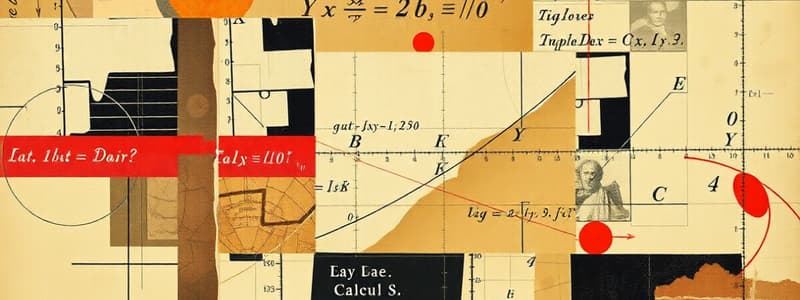Podcast
Questions and Answers
How is the average rate of change calculated?
How is the average rate of change calculated?
- By finding the limit of the function as inputs approach a value.
- By dividing the change in output by the change in input over an interval. (correct)
- By evaluating the function at a single input.
- By integrating the function across a defined range.
What does the Fundamental Theorem of Calculus Part 1 state?
What does the Fundamental Theorem of Calculus Part 1 state?
- An antiderivative cannot be evaluated at the limits of integration.
- The definite integral cannot be computed without limits.
- The derivative of the integral of a function is the function itself. (correct)
- The integral of a function is always constant.
Which of the following best describes a continuous function?
Which of the following best describes a continuous function?
- A function that has vertical asymptotes.
- A function that has no abrupt jumps or breaks in its graph. (correct)
- A function defined only at specific points with gaps in between.
- A function that oscillates indefinitely.
Which types of functions are crucial for understanding calculus concepts?
Which types of functions are crucial for understanding calculus concepts?
What is the instantaneous rate of change of a function?
What is the instantaneous rate of change of a function?
What is the derivative of the function $f(x) = 3x^2 + 2x - 1$?
What is the derivative of the function $f(x) = 3x^2 + 2x - 1$?
What is the main purpose of indefinite integrals?
What is the main purpose of indefinite integrals?
Which of the following is NOT a direct application of derivatives?
Which of the following is NOT a direct application of derivatives?
The Chain Rule in differentiation is used to find the derivative of what type of function?
The Chain Rule in differentiation is used to find the derivative of what type of function?
What does the definite integral represent geometrically?
What does the definite integral represent geometrically?
What is the integration technique used to simplify integrals by changing variables?
What is the integration technique used to simplify integrals by changing variables?
Which of the following is NOT a common application of integral calculus?
Which of the following is NOT a common application of integral calculus?
Which rule of differentiation states that the derivative of a constant is zero?
Which rule of differentiation states that the derivative of a constant is zero?
Flashcards
Calculus
Calculus
A branch of mathematics focused on rates of change and accumulation.
Derivative
Derivative
Represents the instantaneous rate of change of a function.
Integral
Integral
Represents the accumulation of a quantity over an interval.
Differentiation Rules
Differentiation Rules
Signup and view all the flashcards
Power Rule
Power Rule
Signup and view all the flashcards
Indefinite Integral
Indefinite Integral
Signup and view all the flashcards
Definite Integral
Definite Integral
Signup and view all the flashcards
Applications of Derivatives
Applications of Derivatives
Signup and view all the flashcards
Fundamental Theorem of Calculus
Fundamental Theorem of Calculus
Signup and view all the flashcards
Limits
Limits
Signup and view all the flashcards
Continuity
Continuity
Signup and view all the flashcards
Average Rate of Change
Average Rate of Change
Signup and view all the flashcards
Instantaneous Rate of Change
Instantaneous Rate of Change
Signup and view all the flashcards
Study Notes
Introduction to Calculus
- Calculus is a branch of mathematics focused on continuous change, specifically concerned with rates of change (derivatives) and accumulation of quantities (integrals).
- It has two main branches: differential calculus and integral calculus.
Differential Calculus
- Derivatives: Represent the instantaneous rate of change of a function. Geometrically, the derivative at a point is the slope of the tangent line to the function at that point.
- Differentiation Rules: Methods for finding the derivative of various functions.
- Constant rule: The derivative of a constant is zero.
- Power rule: The derivative of xn is nxn-1.
- Sum/difference rule: The derivative of a sum/difference of functions is the sum/difference of their derivatives.
- Product rule: The derivative of the product of two functions is the first function times the derivative of the second, plus the second function times the derivative of the first.
- Quotient rule: The derivative of the quotient of two functions is the denominator times the derivative of the numerator minus the numerator times the derivative of the denominator, all divided by the square of the denominator.
- Chain rule: The derivative of a composite function is the derivative of the outer function evaluated at the inner function, multiplied by the derivative of the inner function.
- Applications of Derivatives: Derivatives are crucial in many fields.
- Finding maximum and minimum values (critical points).
- Determining where a function is increasing or decreasing.
- Calculating velocity and acceleration from position functions.
- Optimization problems.
Integral Calculus
- Integrals: Represent the accumulation of a quantity over an interval.
- Indefinite Integrals: Represent a family of antiderivatives, meaning the function whose derivative is the integrand. They typically have an arbitrary constant.
- Definite Integrals: Determine the area under a curve over a specified interval.
- Integration Techniques: Methods for evaluating integrals.
- Power rule: The integral of xn is (xn+1)/(n+1) + C, (n ≠ -1).
- Substitution (u-substitution): A technique to simplify integrals by changing variables.
- Integration by parts: A technique used to integrate products of functions.
- Partial fraction decomposition: A method for integrating rational functions by decomposing them into simpler fractions.
- Applications of Integrals: Integrals are widely used.
- Calculating areas and volumes.
- Finding displacement and distance traveled given velocity.
- Calculating work done by a variable force.
- Finding probabilities in continuous distributions.
Fundamental Theorem of Calculus
- The Fundamental Theorem of Calculus establishes a fundamental connection between differentiation and integration.
- It states two critical results:
- Part 1: The derivative of the integral of a function is the function itself.
- Part 2: The definite integral of a function can be calculated by evaluating its antiderivative at the limits of integration.
Limits
- Limits: Calculus relies heavily on limits, which describe the behavior of a function as its input approaches a certain value.
- Concept: The foundational idea of continuity and accumulation.
- Application: Calculating derivatives and integrals often involves evaluating limits.
Functions
- Types of functions: Understanding various function types (linear, quadratic, exponential, trigonometric, etc.) is critical for applying calculus concepts.
- Graphing functions: Visual representation aids understanding of function behavior and its relationship to derivatives and integrals.
Other Important Concepts
- Continuity: Functions that are continuous have no abrupt jumps or breaks in their graph.
- Average rate of change: The change in output divided by the change in input over a specific interval.
- Instantaneous rate of change: Rate of change at a precise point. It is the derivative of the function at that particular point.
- Approximations: Techniques to estimate values. Differentiation and integration can provide such approximations.
Studying That Suits You
Use AI to generate personalized quizzes and flashcards to suit your learning preferences.




